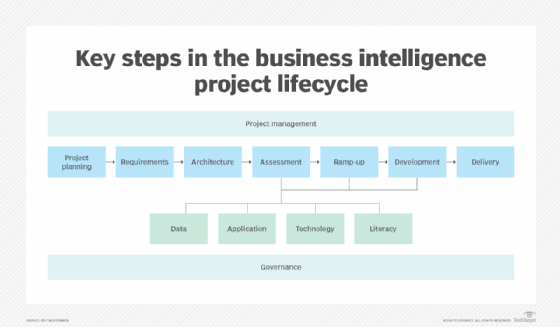How to implement a business intelligence project in 7 steps
The BI implementation process involves a series of steps that organizations need to take to ensure projects are completed successfully and meet business goals.
Business intelligence is a critical component of a data-driven enterprise. In a competitive business environment, the ability of an organization to successfully implement BI projects can mean the difference between winning or losing in the marketplace.
There are two primary drivers of business intelligence projects: compliance and business innovation. Compliance-driven projects are typically in response to laws, regulatory mandates, contractual obligations and corporate policies. In contrast, BI projects driven by innovation are in response to the organization's business strategy -- they aim to deliver tangible business value in the form of efficiencies, cost savings, enhanced operational capabilities and, ultimately, improved business performance. But both project types share a common goal of enabling better business decisions.
They also share a series of implementation steps that can be formalized into a BI project lifecycle. It's a systematic methodology for developing and deploying BI applications that greatly increases the probability of successful initiatives. The sequence of high-level steps outlined in this article serves as a roadmap for an effective BI implementation.
First, though, there are two overarching functions to incorporate into the process. A project management team is responsible for ensuring that objectives are met and projects are delivered on time and on budget. The team's activities focus on keeping the various project steps coordinated and on track. This requires project monitoring capabilities and a communication strategy that continually informs business stakeholders and manages their expectations.
Governance is also an essential component of a BI project to provide oversight, accountability and authority. It's a must to engage a governance team at the start of a project and continue to do so until the implementation is completed.
Now let's look at the seven key steps in the BI implementation process.
1. Create a project plan
A project plan is a framework for successfully completing a BI project. Individual projects are typically discrete initiatives of a larger BI strategy, with executive sponsorship, business buy-in and a supporting business case to justify the required investment. Start the project planning work by clearly defining the business problem your organization wants to solve or the questions it wants answered.
This will assist in defining the project scope, specific business objectives and project success criteria, as well as staffing and scheduling requirements. Doing so will also help to clearly delineate the expected completion of the project to avoid a never-ending one.
2. Gather detailed user requirements
BI is a partnership between various business and IT stakeholders. The project's success is greatly increased with a clear understanding of user requirements. The collective functional and nonfunctional requirements define the specifications of BI capabilities at a detailed level, setting the foundation for the BI architecture that will be deployed. Functional requirements describe the behaviors of the BI application, while nonfunctional ones describe its technical capabilities.
In gathering requirements, start with an understanding of the relevant business processes. Consider who the project is for; what BI tools and data insights they need; and issues such as data quality, how data is formatted and how frequently it's updated. Also, be sure to include concerns about compliance, data security, data privacy and ethics during this step.

3. Design the BI architecture
The underlying business intelligence architecture serves as a blueprint for delivering the planned BI capabilities, with traceability back to the business requirements. In designing the architecture, spend the time needed to sufficiently document the end-to-end data flow and associated technical, business and process metadata that drives analytics uses.
At its core, the BI architecture communicates a vision and plan for transforming data into business value. Realizing the expected value requires a sequence of stages that progressively improves the structure and quality of data, thus enabling users to make data-driven decisions. As part of that sequence, data is converted into information with meaning and context applied. Insights can then be gleaned through analytics and used to drive actions that achieve a desired business outcome and help the BI project meet its business goals.
Following architecture design, the next three project steps incorporate four concurrent tracks -- involving the BI data, applications and technology plus internal data literacy -- in what must be an integrated and well-coordinated effort.
4. Assess organizational readiness for the project
The assessment step is essentially a triaging effort to determine whether the organization is ready for the project. Readiness considers people and processes as well as project constraints, such as the allotted budget and time. Gaps uncovered during this step represent risks to the project that must be addressed.
A data assessment should precede the start of the other tracks to determine if the needed data is available with the right level of detail and sufficient quality to support the business requirements. If this critical task is skipped, you run the risk of delivering a BI project with unusable data that inevitably will be rejected by business users. Identify candidate data sources and do data profiling to assess data quality levels. If data availability and quality fit the purpose of the project, or they can be made to through data curation and data cleansing measures, begin assessments in the other tracks -- otherwise, reevaluate the project.
The application track includes assessing the need for tactical or strategic BI capabilities. Tactical BI applications are primarily day-to-day ones that focus on business operations and are oriented to specific business processes. Strategic applications primarily involve long-term, big-picture analytics that can deliver a combination of past, present and future insights. Discovery is another potential aspect of BI applications to consider -- it's exploratory in nature and uses investigative inquiries to uncover insights.
A technology assessment should determine the feasibility of the BI architecture, including the planned BI platforms, tools and services as well as standards and best practices for data management and information delivery. Evaluate the organization's baseline technology and strategic technology direction in designing the BI environment.
Data literacy is the cornerstone of a data-driven enterprise and arguably the most important component of a successful BI project. Neglecting it is often the reason why harnessing data value remains elusive for organizations. The data literacy track aims to educate the intended users on the data and analytics that are part of a project. This starts with an assessment of current literacy levels to determine required training efforts.
5. Ramp up the implementation
Ramp-up is a step that addresses the gaps uncovered in the assessments. This means different things in each of the four tracks. For example, data curation includes cleansing, conforming, enriching and potentially integrating data sets for planned uses -- all aspects of data preparation. Data also must be organized and structured through data modeling.
An organization needs to close any gaps in its existing technology as well as the people, processes and training required to install and then support the BI system. On data literacy, start by developing a curriculum on how to analyze and interpret the data and communicate BI insights in a meaningful way with business context -- for example, best practices for designing BI dashboards and creating effective data visualizations. Next, train users from corporate executives to front-line workers. The goal here is to transform the DNA of the internal culture so the insights delivered by the BI project can be used to enable better decision-making.
One thing in common across the different tracks is staffing. When creating the project team, look to include in-house BI, IT and business resources to fill different needs. Also, consider the use of external consultants and professional services firms to augment the internal team and cover any gaps in required roles and skills.
6. Develop the BI system
The development step is where the BI environment comes to life. It includes the detailed design and construction of the system, along with the final selection of the BI tools and other technology assets. Component or unit testing is an important task during this step. The BI project can't be delivered -- at least not in an effective way -- unless the environment is successfully tested across all four of the tracks.
Also, incorporate resource mentoring of in-house personnel throughout the development process -- and the other project steps -- to keep valuable knowledge from walking out the door and going elsewhere. This could require bringing in external mentors if the organization doesn't have the needed capacity itself.
7. Deliver and launch the system
The delivery step is the final orchestration and deployment of the BI system. This is where the parallel tracks come together to provide a cohesive environment. The first stage, pre-deployment, is end-to-end testing to verify all aspects of the system. That includes the data pipeline as well as data quality, system operations, performance, usability and business process integration. When verified, the system can be launched and released to the business for use.
Once the BI system is in production use, operational support must be put in place to keep it performing at required levels. This work includes monitoring, tuning and maintenance, among other activities. Strive to automate these tasks as much as possible.
Finally, ensure that any external resources working on the BI implementation transfer relevant knowledge to in-house workers before they transition off of the project. Require written documentation so the knowledge can be preserved for future reference and onboarding of new IT or BI team members.
After the implementation
The fate of a BI project ultimately depends on the use of the system and its ability to meet the success criteria identified at the start of the project. Post-implementation surveys, interviews and monitoring of key metrics are useful techniques to gauge achievements. Assuming the project is delivered on time and on budget, success can be measured by answering these three simple questions, backed up by KPIs and other metrics:
- Is the project aligned to the business strategy?
- Is the project driving business decisions?
- Is the project delivering promised business value?
For many organizations, deriving value from data can be elusive. BI projects are an attempt to maximize the value of data by delivering actionable insights that drive business decision-making and outcomes. A BI project lifecycle provides a general flow of the steps required to implement an effective project.
But BI projects can take on many forms. For this reason, the lifecycle detailed here is best used as a reference framework. Organizations should customize it to meet the specific needs of their projects. Whatever form it takes in the end, having a solid framework to implement business intelligence greatly increases the probability of success.
Jeff McCormick is an enterprise data architect and IT principal who has extensive experience in data-related IT roles. He is also an inventor, patent holder, freelance writer and industry presenter.








